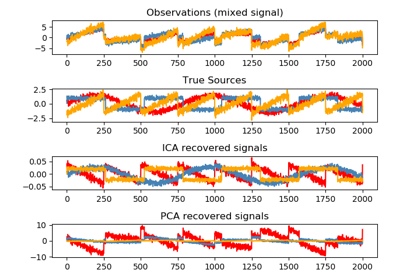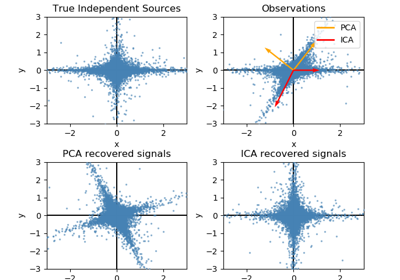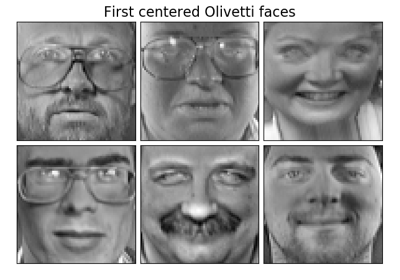sklearn.decomposition.FastICA¶
-
class
sklearn.decomposition.FastICA(n_components=None, algorithm='parallel', whiten=True, fun='logcosh', fun_args=None, max_iter=200, tol=0.0001, w_init=None, random_state=None)[source]¶ FastICA: a fast algorithm for Independent Component Analysis.
Read more in the User Guide.
- Parameters
- n_componentsint, optional
Number of components to use. If none is passed, all are used.
- algorithm{‘parallel’, ‘deflation’}
Apply parallel or deflational algorithm for FastICA.
- whitenboolean, optional
If whiten is false, the data is already considered to be whitened, and no whitening is performed.
- funstring or function, optional. Default: ‘logcosh’
The functional form of the G function used in the approximation to neg-entropy. Could be either ‘logcosh’, ‘exp’, or ‘cube’. You can also provide your own function. It should return a tuple containing the value of the function, and of its derivative, in the point. Example:
- def my_g(x):
return x ** 3, (3 * x ** 2).mean(axis=-1)
- fun_argsdictionary, optional
Arguments to send to the functional form. If empty and if fun=’logcosh’, fun_args will take value {‘alpha’ : 1.0}.
- max_iterint, optional
Maximum number of iterations during fit.
- tolfloat, optional
Tolerance on update at each iteration.
- w_initNone of an (n_components, n_components) ndarray
The mixing matrix to be used to initialize the algorithm.
- random_stateint, RandomState instance or None, optional (default=None)
If int, random_state is the seed used by the random number generator; If RandomState instance, random_state is the random number generator; If None, the random number generator is the RandomState instance used by
np.random.
- Attributes
- components_2D array, shape (n_components, n_features)
The linear operator to apply to the data to get the independent sources. This is equal to the unmixing matrix when
whitenis False, and equal tonp.dot(unmixing_matrix, self.whitening_)whenwhitenis True.- mixing_array, shape (n_features, n_components)
The pseudo-inverse of
components_. It is the linear operator that maps independent sources to the data.- mean_array, shape(n_features)
The mean over features. Only set if
self.whitenis True.- n_iter_int
If the algorithm is “deflation”, n_iter is the maximum number of iterations run across all components. Else they are just the number of iterations taken to converge.
- whitening_array, shape (n_components, n_features)
Only set if whiten is ‘True’. This is the pre-whitening matrix that projects data onto the first
n_componentsprincipal components.
Notes
Implementation based on A. Hyvarinen and E. Oja, Independent Component Analysis: Algorithms and Applications, Neural Networks, 13(4-5), 2000, pp. 411-430
Examples
>>> from sklearn.datasets import load_digits >>> from sklearn.decomposition import FastICA >>> X, _ = load_digits(return_X_y=True) >>> transformer = FastICA(n_components=7, ... random_state=0) >>> X_transformed = transformer.fit_transform(X) >>> X_transformed.shape (1797, 7)
Methods
fit(self, X[, y])Fit the model to X.
fit_transform(self, X[, y])Fit the model and recover the sources from X.
get_params(self[, deep])Get parameters for this estimator.
inverse_transform(self, X[, copy])Transform the sources back to the mixed data (apply mixing matrix).
set_params(self, \*\*params)Set the parameters of this estimator.
transform(self, X[, copy])Recover the sources from X (apply the unmixing matrix).
-
__init__(self, n_components=None, algorithm='parallel', whiten=True, fun='logcosh', fun_args=None, max_iter=200, tol=0.0001, w_init=None, random_state=None)[source]¶ Initialize self. See help(type(self)) for accurate signature.
-
fit(self, X, y=None)[source]¶ Fit the model to X.
- Parameters
- Xarray-like, shape (n_samples, n_features)
Training data, where n_samples is the number of samples and n_features is the number of features.
- yIgnored
- Returns
- self
-
fit_transform(self, X, y=None)[source]¶ Fit the model and recover the sources from X.
- Parameters
- Xarray-like, shape (n_samples, n_features)
Training data, where n_samples is the number of samples and n_features is the number of features.
- yIgnored
- Returns
- X_newarray-like, shape (n_samples, n_components)
-
get_params(self, deep=True)[source]¶ Get parameters for this estimator.
- Parameters
- deepbool, default=True
If True, will return the parameters for this estimator and contained subobjects that are estimators.
- Returns
- paramsmapping of string to any
Parameter names mapped to their values.
-
inverse_transform(self, X, copy=True)[source]¶ Transform the sources back to the mixed data (apply mixing matrix).
- Parameters
- Xarray-like, shape (n_samples, n_components)
Sources, where n_samples is the number of samples and n_components is the number of components.
- copybool (optional)
If False, data passed to fit are overwritten. Defaults to True.
- Returns
- X_newarray-like, shape (n_samples, n_features)
-
set_params(self, **params)[source]¶ Set the parameters of this estimator.
The method works on simple estimators as well as on nested objects (such as pipelines). The latter have parameters of the form
<component>__<parameter>so that it’s possible to update each component of a nested object.- Parameters
- **paramsdict
Estimator parameters.
- Returns
- selfobject
Estimator instance.
-
transform(self, X, copy=True)[source]¶ Recover the sources from X (apply the unmixing matrix).
- Parameters
- Xarray-like, shape (n_samples, n_features)
Data to transform, where n_samples is the number of samples and n_features is the number of features.
- copybool (optional)
If False, data passed to fit are overwritten. Defaults to True.
- Returns
- X_newarray-like, shape (n_samples, n_components)



